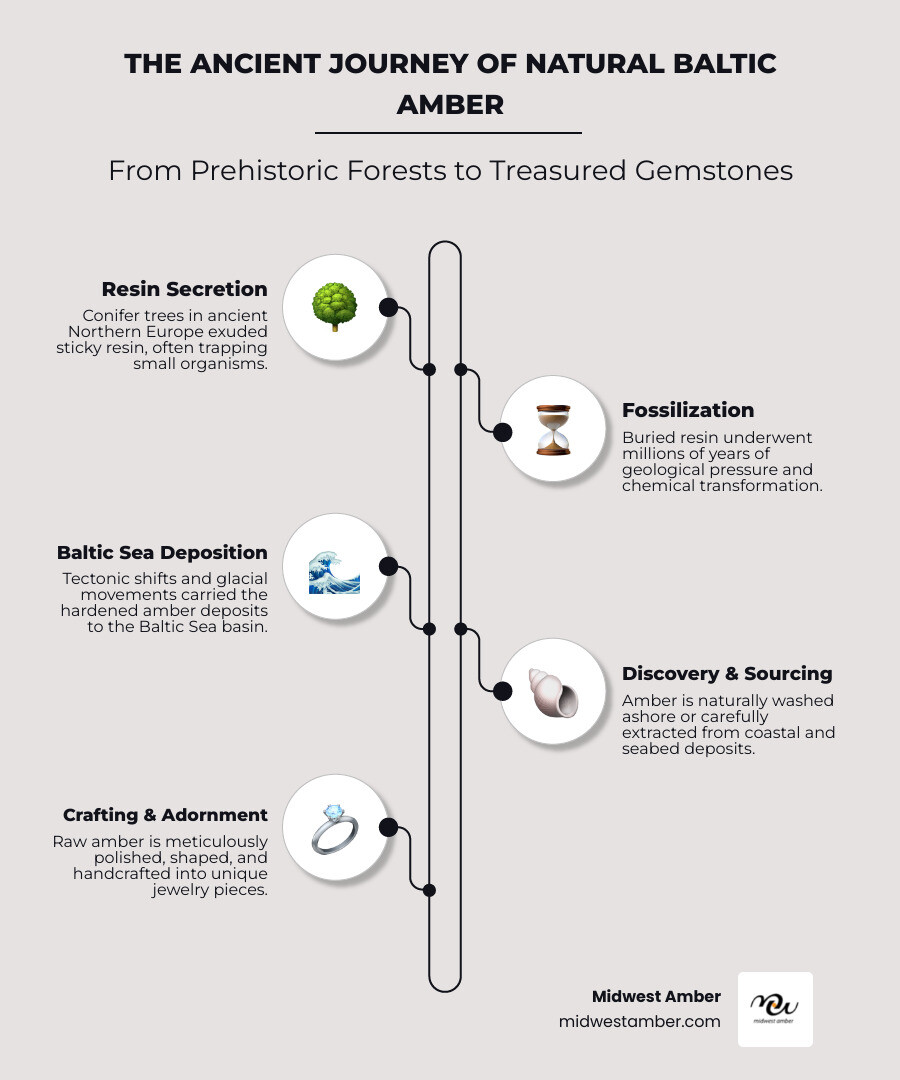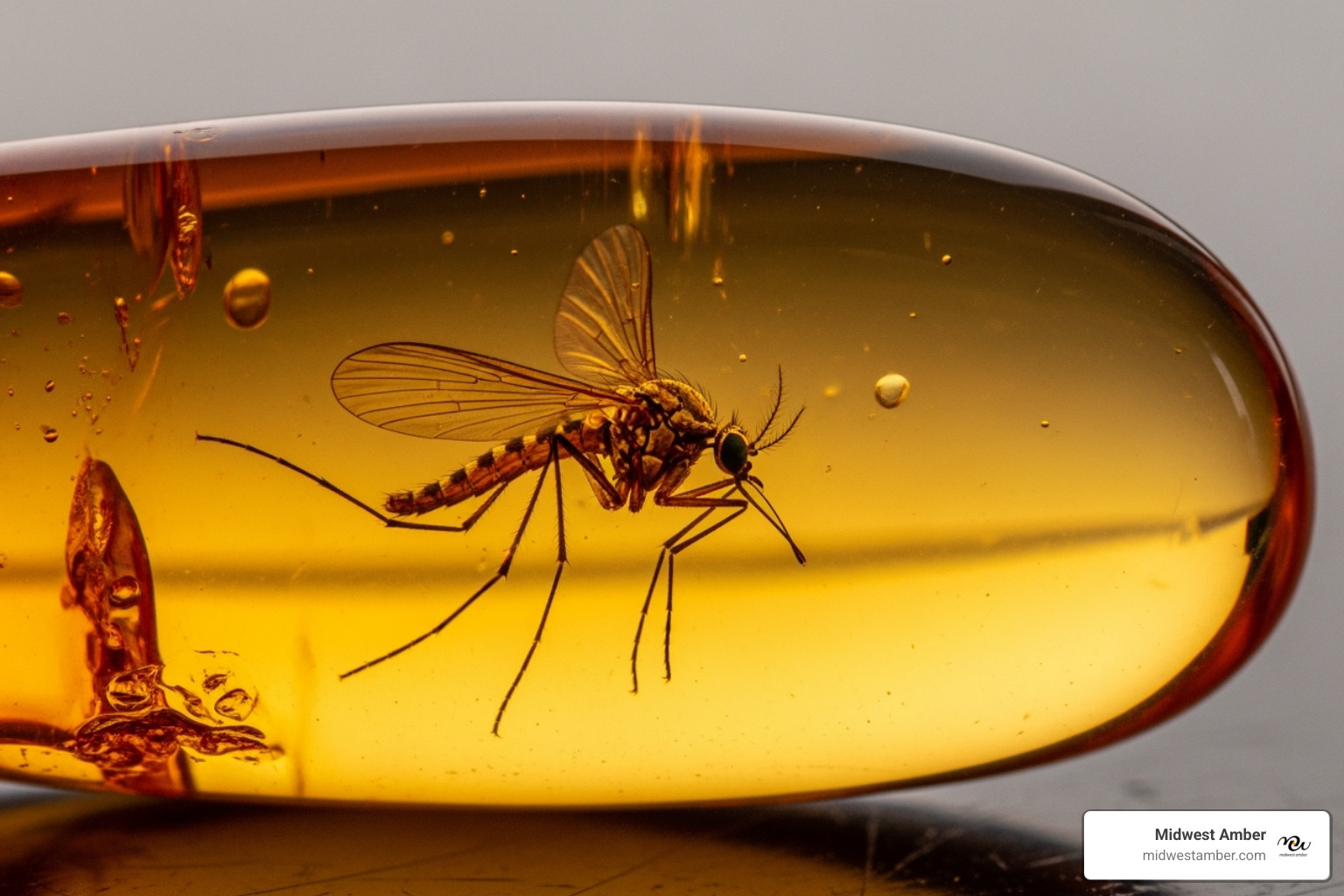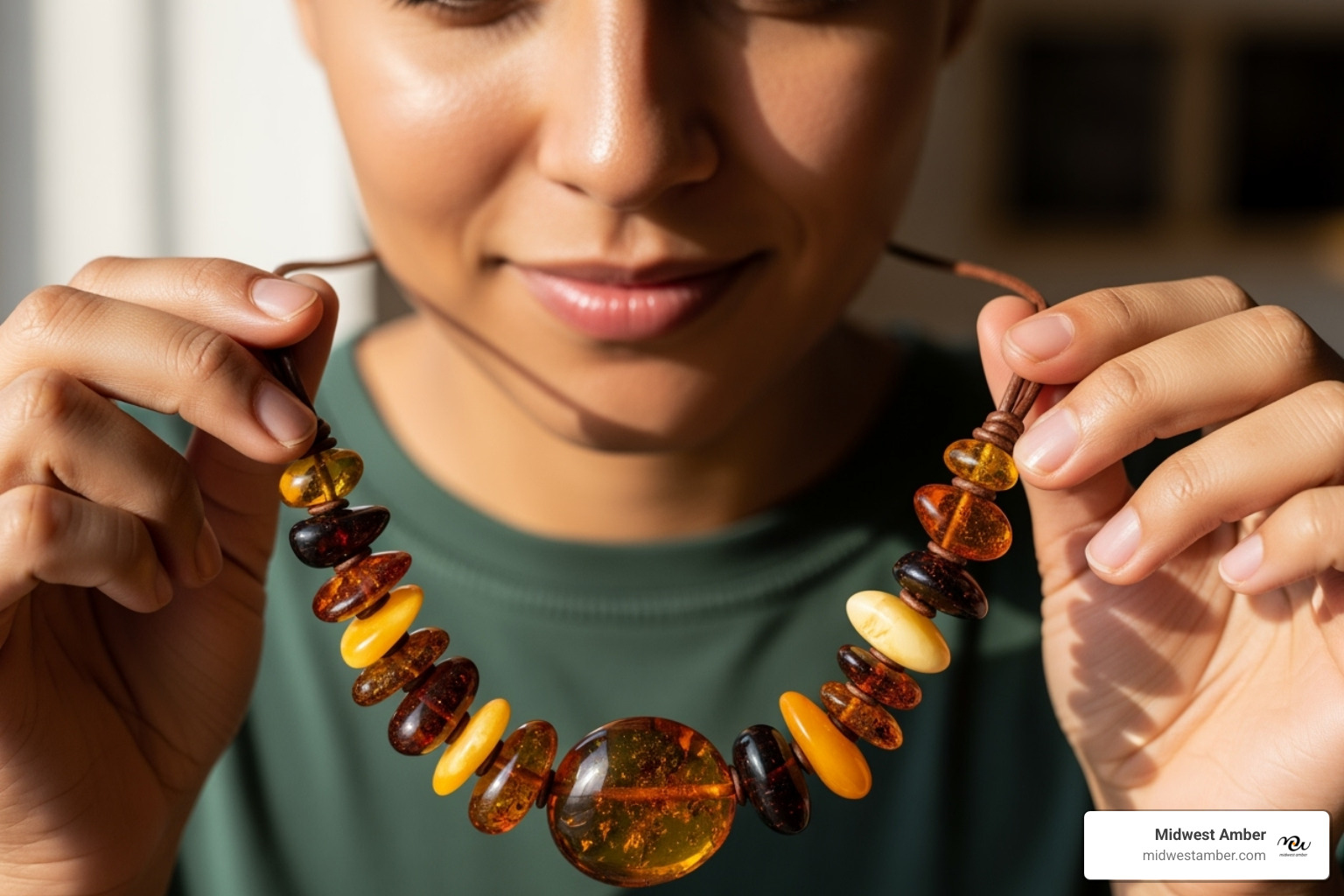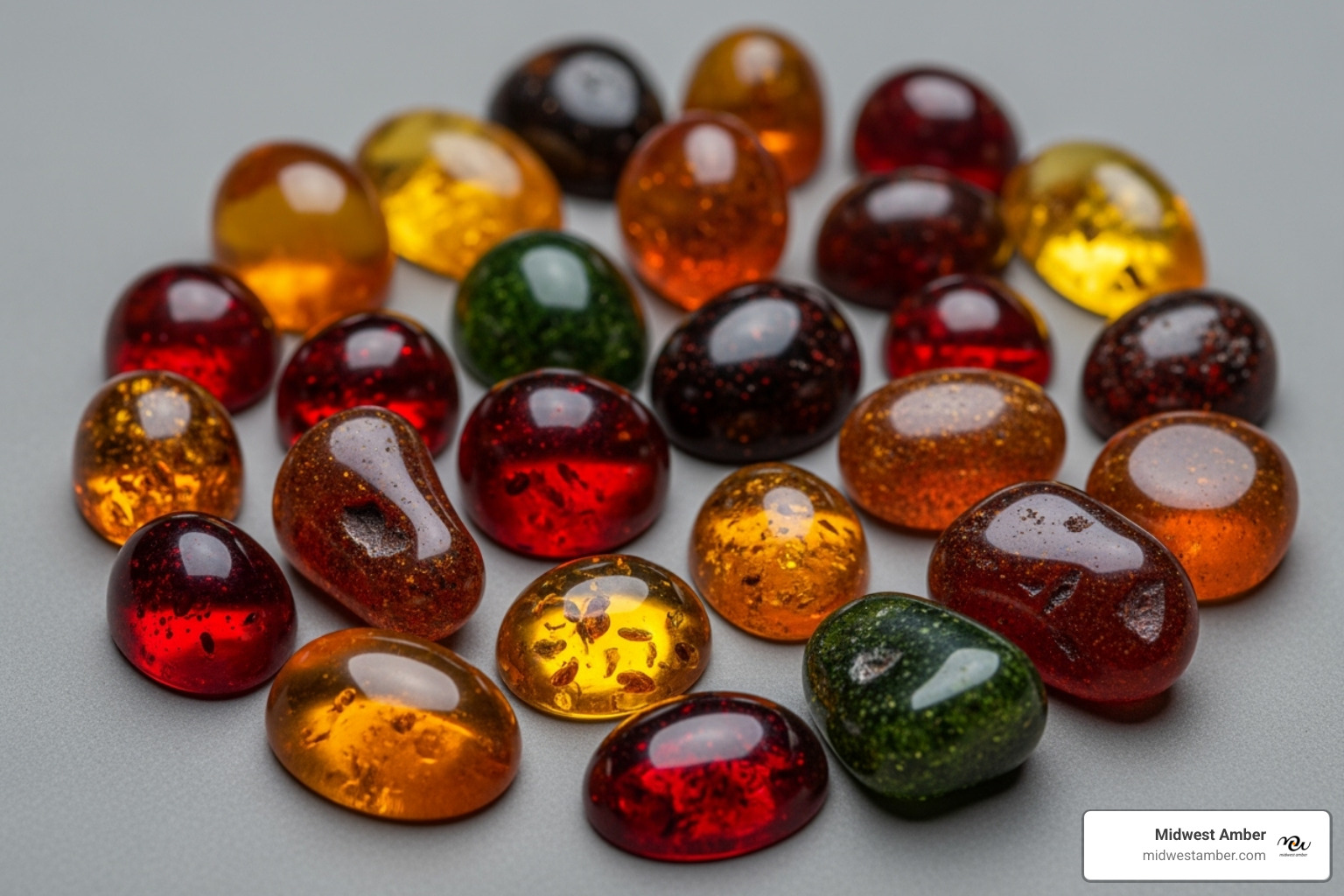Why Natural Baltic Amber Captivates Jewelry Lovers Worldwide
Natural Baltic amber is fossilized tree resin that formed 40-60 million years ago from ancient conifer forests in Northern Europe. This organic gemstone has captivated humans for millennia with its warm golden hues, prehistoric inclusions, and purported healing properties.
Key Properties of Natural Baltic Amber:
- Age: 40-60 million years old fossilized resin
- Origin: Ancient forests of Northern Europe, now found along Baltic Sea shores
- Composition: 79% carbon, 10.5% hydrogen, 10.5% oxygen, plus 3-8% succinic acid
- Colors: Honey, cognac, cherry, lemon, green, and rare blue varieties
- Unique features: May contain trapped insects, plants, and air bubbles from prehistoric times
- Believed benefits: Pain relief, stress reduction, immune support (traditional claims)
As Martin Luther once carried amber in his pocket believing it could protect him from kidney stones, this "living" gemstone continues to bridge ancient wisdom with modern fascination. Unlike other precious stones formed deep in the earth, amber offers a tangible connection to prehistoric life - sometimes preserving entire insects that lived when dinosaurs roamed the earth.
The allure goes beyond its beauty. Baltic amber contains over 40 compounds, including succinic acid, which has led to centuries of use in folk medicine. From ancient Roman physicians mixing amber powder with honey to treat ailments, to modern parents choosing amber teething necklaces, this fossilized resin maintains its reputation as nature's pharmacy.
About the Author: I'm Gabriel Ciupek, President and owner of Midwest Amber, Inc. As a US-based company, we've spent years working directly with European suppliers to ensure the highest quality natural Baltic amber reaches our customers. My experience provides deep insight into authentic sourcing, quality verification, and the unique properties that make each piece of amber jewelry one-of-a-kind.

The Ancient Origins of Baltic Amber

This section explores the fascinating history and formation of natural Baltic amber, a true relic of a prehistoric world.
From Prehistoric Forests to the Baltic Sea
Picture this: 40 to 60 million years ago, long before humans walked the Earth, massive coniferous forests covered what we now call Northern Europe. These weren't just any trees - they were ancient giants that produced thick, sticky resin as protection against insects and wounds.
When storms damaged these prehistoric trees or climate changes stressed them, they oozed enormous amounts of golden resin. This sticky substance flowed down tree trunks like slow honey, trapping everything in its path - tiny insects, delicate leaves, even air bubbles from that ancient world.
Over millions of years, rivers and streams carried this hardened resin toward the Baltic Sea. There, buried under layers of sand and sediment, something magical happened. The intense pressure and geological changes slowly transformed the resin through a process called polymerization.
What emerged was natural Baltic amber - a fossilized treasure that's 79% carbon, 10.5% hydrogen, and 10.5% oxygen, plus over 40 other fascinating compounds. This incredible journey from living tree to precious gemstone makes amber unlike any other jewelry material on Earth. To dive deeper into its unique properties, check out What is Baltic Amber?
A Window to the Past: The Significance of Inclusions
Here's where natural Baltic amber gets truly extraordinary. Those prehistoric insects and plant fragments trapped in the flowing resin? They're still there, perfectly preserved after millions of years. It's like nature created the ultimate time capsule.
Scientists have identified over 1,000 extinct species of insects from amber inclusions alone. Imagine - you could be wearing a necklace that contains a mosquito that lived when dinosaurs roamed the Earth! These inclusions aren't just scientifically priceless; they make each piece of amber jewelry completely unique.
Plant fragments tell us about ancient forests and climates. Air bubbles preserve the actual atmosphere from prehistoric times. Trapped insects show us creatures that vanished long before humans existed. Every inclusion is a frozen moment from a world we can only dream about.
This is what makes natural Baltic amber so much more than just beautiful jewelry. When you hold a piece with inclusions, you're literally holding a piece of prehistoric life in your hands. The aesthetic beauty combined with this incredible scientific value creates something truly special.
Want to learn more about amber's rich history? Explore The History of Baltic Amber for even more fascinating details about this ancient treasure.
The Healing Legacy: Purported Therapeutic Properties
This section digs into the long-held beliefs about amber's health benefits, from ancient folk remedies to modern wellness theories.
Historical Use in Folk Medicine
The story of natural Baltic amber goes far beyond its stunning golden beauty. For thousands of years, people have treasured this fossilized resin not just as jewelry, but as a powerful healing tool. Our fascination with amber's therapeutic powers stretches back to the [Paleolithic Age](http://www.britannica.com/event/Paleolithic-Period), when early humans first found these glowing treasures washed up on ancient shores.
Ancient Romans were convinced of amber's healing magic. Physicians like Hippocrates wrote about its powers, believing it could protect from madness and treat throat, ear, and eye diseases when mixed with honey. Pliny the Younger noted that Roman peasant women wore amber medallions to cure swollen glands and sore throats, a tradition we still explore today.
Medieval healers continued this tradition, believing amber beads could absorb illness like jaundice. Alchemists also created medicinal amber preparations like Oleum succini and Extractum succini.
Famous figures like Martin Luther carried natural Baltic amber in his pocket, believing it protected him from kidney stones. Lithuanian grandmothers traditionally wore amber beads for health and protection, even using it as a natural antibiotic, showcasing the versatile applications of [Natural Healing Properties](https://en.wikipedia.org/wiki/Naturopathy) passed down through generations.
The Science Behind the Claims: Succinic Acid Explained
So what makes natural Baltic amber so special that people have believed in its healing powers for millennia? The answer lies in a remarkable compound called [succinic acid](http://en.wikipedia.org/wiki/Succinic_acid). While this substance appears naturally in many plants and animal tissues, natural Baltic amber contains an unusually high concentration - between 3-8% - with the highest levels found in the amber's outer layer.
Here's where it gets fascinating. When amber jewelry touches your skin and warms up from your body heat, tiny amounts of succinic acid are believed to be released. Your skin then absorbs these microscopic amounts into your bloodstream, where the acid can potentially work its anti-inflammatory and pain-relieving magic.
The scientific community has taken notice too. Nobel Prize winner [Robert Koch](http://en.wikipedia.org/wiki/Robert_Koch) conducted research confirming that succinic acid has positive effects on the human body. His studies showed it can strengthen the body, boost immunity, and help maintain proper acid balance. Koch also found there's no risk of succinic acid building up harmfully in your system, as the body processes it safely.
What's truly remarkable is that natural Baltic amber contains succinic acid in concentrations up to a thousand times higher than even the richest natural sources like unripe gooseberries or rhubarb stalks. However, it's important to be honest about the research. While the historical use and countless personal stories are compelling, large-scale modern clinical trials specifically testing amber jewelry for medical conditions are still limited. Most scientific studies focus on succinic acid in pharmaceutical applications rather than amber jewelry itself.
Common Conditions Amber is Believed to Help
At Midwest Amber, we've heard many stories from customers about natural Baltic amber's healing properties. While we always recommend consulting healthcare professionals for medical concerns, these personal experiences are worth sharing. You can learn more about these claims in our detailed guide on [The Healing Properties of Baltic Amber](https://midwestamber.com/blogs/news/the-healing-properties-of-baltic-amber).
Teething pain relief remains the most famous use of amber jewelry. Parents often report that amber necklaces help reduce their babies' teething symptoms like red cheeks, gum discomfort, and fussiness. For example, one mother shared that her child's gum pain improved dramatically within a week.
Arthritis and joint pain sufferers often turn to amber for relief. We've received testimonials about improvements in arthritis, tendinitis, and back pain. One customer, Anna Karina, reported both pain relief and an improved mood from her necklace.
Many believe natural Baltic amber can reduce the frequency and intensity of headaches and migraines. Customer Tania Lopes reported feeling calmer and headache-free with her amber necklace.
Stress and anxiety reduction represents another major area where people turn to amber's calming influence. Thais Gomes shared that her daughter became much calmer and slept better after wearing an amber necklace.
Some believe amber supports the immune system, helping with recovery from illnesses. Customer Raquel uses amber jewelry for her family's immunity. Others report improvements in inflammation-related pain beyond arthritis, including fever, growing pains in children, and sports injuries in teens.
Some users report benefits for digestive issues like colic and reflux, skin conditions like eczema, allergies, cramps, and sleep quality. Laina Oliveira, for instance, noticed improvements in her daughter's allergies and sleep.
These experiences represent traditional beliefs and personal stories from our valued customers. While we treasure these testimonials, we always encourage consulting with healthcare professionals for any medical concerns.
A Guide to Choosing and Owning Natural Baltic Amber Jewelry

Practical advice for selecting, verifying, and maintaining your amber pieces to ensure their longevity and beauty.
Identifying Genuine Natural Baltic Amber
When you're shopping for natural Baltic amber, knowing how to spot the real deal is crucial. Unfortunately, the popularity of amber has led to a flood of imitations made from everything from plastic to glass, and even younger resins like copal that haven't had time to fully fossilize.
At Midwest Amber, we've spent over 20 years building relationships with trusted suppliers in Poland and Lithuania, bringing these authentic treasures to our US customers. Every piece we sell is certified, so you never have to worry. But if you're curious, here are some reliable ways to test amber at home.
The saltwater test is a safe method. Mix two tablespoons of salt into a cup of water. Genuine natural Baltic amber is light and will float, while most fakes (plastic, glass) will sink.
Under a UV light, genuine amber often glows with a blue or green fluorescence, revealing its ancient properties.
The scent test is also telling. Rubbing genuine amber vigorously warms it and releases a subtle pine-like scent. Plastic imitations will smell chemical, and glass has no scent.
The hot needle test is another option, but use extreme caution as it can damage your piece. A hot needle touched to real amber will release a pine scent. This test is risky and unnecessary if you buy from a certified, reputable source.
Raw vs. Polished: Does it Make a Difference?
One of the most common questions we get is whether to choose raw or polished natural Baltic amber. Both are absolutely genuine, but they offer different experiences and aesthetics.
Raw amber has an earthy, organic feel. It's matte and slightly rough, retaining the highest concentration of succinic acid on its unaltered surface. For this reason, many who seek amber's therapeutic properties prefer raw pieces, enjoying a connection to its natural state.
Polished amber, on the other hand, is pure elegance. The polishing process reveals the amber's inner beauty - those rich honey, cognac, and cherry colors become vibrant and translucent. The surface is smooth as silk and catches light beautifully. While some of the surface succinic acid may be reduced during polishing, the amber still contains plenty of this beneficial compound throughout.
The texture difference is notable. Raw amber feels natural and grounding, with a rustic charm perfect for casual styles. Polished amber feels refined and luxurious, creating stunning jewelry (especially when set in 925 sterling silver) for any occasion.
When it comes to care, polished amber is generally easier to maintain. Its smooth surface doesn't absorb oils and dirt as readily as raw amber, making it simpler to keep clean. Raw amber requires a gentler touch and may need more frequent, careful cleaning.
The choice really comes down to your personal style and intentions. Are you drawn to the untouched, natural beauty and potentially higher therapeutic value of raw amber? Or do you prefer the refined elegance and easier maintenance of polished pieces? There's no wrong answer - both forms showcase the incredible journey of this ancient gemstone.
Caring for Your Amber Treasures
Your natural Baltic amber jewelry is millions of years in the making, so it deserves proper care to keep it beautiful for generations to come. The good news is that caring for amber is straightforward once you understand its gentle nature.
Think of amber as having the hardness of your fingernail - it rates only 2-2.5 on the Mohs scale. This softness is part of its charm, but it also means amber needs protection from harder materials that could scratch it.
Chemical sensitivity is amber's biggest weakness. Perfumes, hairsprays, lotions, and cleaning products can dull the surface or even cause cracking. Make amber the last thing you put on and the first thing you take off. Apply perfumes and lotions first, let them dry, then add your jewelry.
For cleaning, simplicity is key. A soft, damp cloth is usually all you need. If your amber needs a deeper clean, use the mildest soap you have, like baby shampoo. Rinse thoroughly with clean water and pat dry immediately. Never use ultrasonic cleaners or harsh brushes.
Storage is crucial for preventing scratches. Keep your amber pieces in soft pouches or separate compartments in your jewelry box, away from harder gemstones or metals.
Temperature extremes are amber's enemy. Direct sunlight, hot car dashboards, or very hot water can cause amber to dry out, crack, or change color. Amber softens at around 150°C and melts at 300°C, so keep it away from heat sources. Extreme cold can also make it brittle.
For detailed care instructions and tips, check out our comprehensive guide on How to Care for Your Baltic Amber Jewelry.
With these simple care practices, your natural Baltic amber will continue to glow with that warm, ancient light that has captivated humans for thousands of years. It's a small investment of time that ensures your amber treasures remain as beautiful as the day you first fell in love with them.
Frequently Asked Questions about Natural Baltic Amber
Addressing the most common questions and concerns consumers have about this unique gemstone.
Is it safe for babies to wear amber teething necklaces?
Natural Baltic amber teething necklaces have gained immense popularity as a natural remedy for teething discomfort. Many parents swear by them, reporting reduced fussiness, pain, and inflammation in their little ones. However, it's crucial to address the safety concerns associated with wearing any necklace, especially for infants.
The primary risks are choking and strangulation. To mitigate these risks, reputable manufacturers, including us at Midwest Amber, incorporate specific safety features:
- Individually Knotted Beads: Each bead on our teething necklaces is individually knotted. This design ensures that if the necklace were to break, only one bead would come loose, significantly reducing the choking hazard.
- Secure Clasps: Our necklaces typically feature plastic clasps with screw threads or breakaway clasps that are designed to open if excessive pressure is applied, minimizing the risk of strangulation.
- Rounded, Smooth Beads: The beads are carefully shaped to be smooth and rounded, ensuring comfort for the baby and preventing any irritation.
Despite these safety features, natural Baltic amber teething necklaces require constant adult supervision. We strongly recommend:
- Always supervise your baby when they are wearing the necklace.
- Remove the necklace during naps, bedtime, or any time the baby is unsupervised.
- Consider wrapping the necklace around an ankle or wrist under clothing as an alternative.
While many medical and pediatric associations, like the American Academy of Pediatrics (AAP), advise against wearing any jewelry around an infant's neck due to potential risks, we believe that informed parents, coupled with products designed with safety in mind and vigilant supervision, can make responsible choices.
How is Baltic amber sourced ethically?
At Midwest Amber, we are deeply committed to ethical and sustainable sourcing practices. The vast majority of the world's natural Baltic amber (approximately 90%) is found in the Baltic Sea region, primarily in countries like Poland and Lithuania. This is where our journey begins.
Our amber is sustainably sourced, meaning we work with suppliers who adhere to responsible extraction methods. Traditionally, amber has been collected from the seashore after storms, or through careful excavation of the "blue ground" layer where it's found. We partner directly with experienced, often multi-generational, family businesses and skilled artisans in these regions.
Our jewelry is handcrafted by exceptional Lithuanian artisans who transform raw amber into beautiful pieces. As a US-based company, we are proud to support this traditional craftsmanship, avoiding mass production and preserving the art of amber jewelry making. This direct partnership, dating back to our founding in 1997, allows us to ensure the authenticity and ethical provenance of every piece of natural Baltic amber we offer, often set in 925 sterling silver to honor its ancient origins.
What are the different colors of natural Baltic amber?

One of the most enchanting aspects of natural Baltic amber is its incredible diversity of colors. While often associated with warm golden tones, amber actually comes in a spectrum of hues, each with its unique charm and story. Scientists count about 250 various colors and shades! Explore the full range of [Types of Baltic Amber](https://midwestamber.com/blogs/news/types-of-baltic-amber).
The color of natural Baltic amber is influenced by several factors, including the volatile elements present during its formation, the presence of various admixtures, and the degree of oxidation over millions of years. Even tiny air bubbles, up to 900,000 per square millimeter in opaque pieces, can affect its perceived color and transparency.
Here's a breakdown of the most common and rare colors you might encounter:
- Honey and Cognac: These classic golden-yellow to brownish-orange tones are the most common (about 70% of all amber) and are often transparent or semi-transparent.
- Cherry and Lemon: Cherry amber is a deep red to dark brown, often intensified with heat treatment. Lemon amber is a bright, pale yellow.
- Green: A rare color (about 2% of all amber), its subtle green hue comes from natural impurities or organic matter.
- White: Known as "royal amber," this rare (1-2%) variety is opaque and creamy due to a high concentration of microscopic air bubbles.
- Blue: The rarest shade (about 0.2%), its captivating blue fluorescence is visible under specific lighting, caused by light scattering from tiny impurities.
- Black: This frequent variety (around 15%) is actually very dark brown amber, appearing black due to a high concentration of organic inclusions.
Each color of natural Baltic amber offers a unique aesthetic, allowing us to craft jewelry that ranges from classic elegance to bold, statement pieces. Whether you're drawn to the traditional warmth of honey or the mystical allure of green, there's a shade of natural Baltic amber to suit every taste and complement any outfit.
Conclusion
Our journey through natural Baltic amber has taken us from prehistoric forests to modern jewelry boxes, revealing a gemstone that defies ordinary classification. This isn't just another pretty stone - it's a 40-million-year-old time capsule that somehow managed to preserve tiny insects, ancient air bubbles, and healing compounds that continue to fascinate us today.
What makes natural Baltic amber so special is how it bridges the gap between science and wonder. One moment you're marveling at a perfectly preserved prehistoric mosquito trapped inside, and the next you're hearing from a parent whose teething baby finally got some relief. It's simultaneously a paleontologist's dream and a jewelry lover's treasure.
The rich tradition surrounding amber spans cultures and centuries. From Roman physicians mixing amber powder into healing remedies to modern Lithuanian artisans crafting each piece by hand, this fossilized resin has woven itself into the fabric of human history. The fact that it contains succinic acid - a compound that even Nobel Prize winners have studied - adds a layer of scientific intrigue to its ancient mystique.
At Midwest Amber, we've been honored to be part of this story for over two decades. As a US-based family business, we take pride in connecting our customers with genuine natural Baltic amber handcrafted by skilled Lithuanian artisans. When you choose one of our pieces, you're supporting traditional craftsmanship and receiving something truly ancient and authentic.
Whether you're drawn to the warm honey tones that glow like captured sunlight, intrigued by the rare green varieties, or hoping to experience the wellness benefits that have been cherished for millennia, natural Baltic amber offers something genuinely unique in our modern world.
Explore our full collection of handcrafted Baltic amber jewelry and find your own piece of prehistoric wonder. After all, how often do you get the chance to wear a piece of history that's older than the dinosaurs?




Leave a comment
This site is protected by hCaptcha and the hCaptcha Privacy Policy and Terms of Service apply.